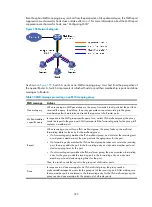
404
MLD snooping forwarding table, and the hosts on this port join IPv6 multicast groups again until the
number of IPv6 multicast groups that the port joins reaches the maximum value. When the port joins an
IPv6 multicast group, if the port has been configured as a static member port, the system applies the
configurations to the port again. If you have configured simulated joining on the port, the system
establishes corresponding forwarding entry for the port after receiving a report from the simulated
member host.
To set the maximum number of IPv6 multicast groups that a port can join:
Step Command
Remarks
1.
Enter system view.
system-view
N/A
2.
Enter Layer 2 Ethernet
interface view or Layer 2
aggregate interface view or
enter port group view.
•
Enter Layer 2 Ethernet interface
view or Layer 2 aggregate
interface view:
interface
interface-type
interface-number
•
Enter port group view:
port-group
manual
port-group-name
Use either method.
3.
Set the maximum number of
IPv6 multicast groups that a
port can join.
mld-snooping group-limit
limit
[
vlan
vlan-list
]
The default value is 128.
Enabling IPv6 multicast group replacement
For various reasons, the number of IPv6 multicast groups that a switch or a port can join might exceed the
upper limit. In addition, in some specific applications, an IPv6 multicast group that the switch newly joins
must replace an existing IPv6 multicast group automatically. A typical example is channel switching. To
view a new TV channel, a user switches from the current IPv6 multicast group to the new one.
To realize such requirements, you can enable the IPv6 multicast group replacement function on the switch
or on a certain port. When the number of IPv6 multicast groups that the switch or the port has joined
reaches the limit, one of the following occurs:
•
If the IPv6 multicast group replacement feature is disabled, new MLD reports are automatically
discarded.
•
If the IPv6 multicast group replacement feature is enabled, the IPv6 multicast group that the switch
or the port newly joins automatically replaces an existing IPv6 multicast group that has the lowest
IPv6 address.
IMPORTANT:
Be sure to configure the maximum number of IPv6 multicast groups that a port can join to a value other
than the default one (see "
Setting the maximum number of multicast groups that a port can join
)" before
enabling IPv6 multicast group replacement. Otherwise, the IPv6 multicast group replacement function
does not take effect.
Enabling IPv6 multicast group replacement globally
Step Command
Remarks
1.
Enter system view.
system-view
N/A
















































